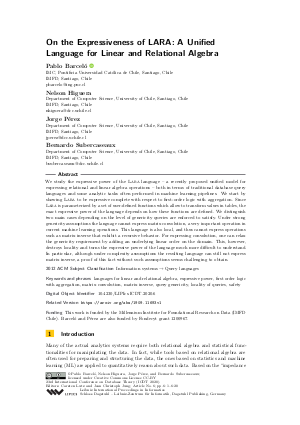On the Expressiveness of LARA: A Unified Language for Linear and Relational Algebra
Authors
Pablo Barceló  ,
Nelson Higuera,
Jorge Pérez,
Bernardo Subercaseaux
,
Nelson Higuera,
Jorge Pérez,
Bernardo Subercaseaux
-
Part of:
Volume:
23rd International Conference on Database Theory (ICDT 2020)
Part of: Series: Leibniz International Proceedings in Informatics (LIPIcs)
Part of: Conference: International Conference on Database Theory (ICDT) - License:
 Creative Commons Attribution 3.0 Unported license
Creative Commons Attribution 3.0 Unported license
- Publication Date: 2020-03-11
File

PDF
LIPIcs.ICDT.2020.6.pdf
- Filesize: 0.67 MB
- 20 pages
Document Identifiers
Related Versions
Subject Classification
ACM Subject Classification
- Information systems → Query languages
Keywords
- languages for linear and relational algebra
- expressive power
- first order logic with aggregation
- matrix convolution
- matrix inverse
- query genericity
- locality of queries
- safety
Metrics
- Access Statistics
-
Total Accesses (updated on a weekly basis)
0PDF Downloads0Metadata Views
Abstract
We study the expressive power of the Lara language - a recently proposed unified model for expressing relational and linear algebra operations - both in terms of traditional database query languages and some analytic tasks often performed in machine learning pipelines. We start by showing Lara to be expressive complete with respect to first-order logic with aggregation. Since Lara is parameterized by a set of user-defined functions which allow to transform values in tables, the exact expressive power of the language depends on how these functions are defined. We distinguish two main cases depending on the level of genericity queries are enforced to satisfy. Under strong genericity assumptions the language cannot express matrix convolution, a very important operation in current machine learning operations. This language is also local, and thus cannot express operations such as matrix inverse that exhibit a recursive behavior. For expressing convolution, one can relax the genericity requirement by adding an underlying linear order on the domain. This, however, destroys locality and turns the expressive power of the language much more difficult to understand. In particular, although under complexity assumptions the resulting language can still not express matrix inverse, a proof of this fact without such assumptions seems challenging to obtain.
Cite As Get BibTex
Pablo Barceló, Nelson Higuera, Jorge Pérez, and Bernardo Subercaseaux. On the Expressiveness of LARA: A Unified Language for Linear and Relational Algebra. In 23rd International Conference on Database Theory (ICDT 2020). Leibniz International Proceedings in Informatics (LIPIcs), Volume 155, pp. 6:1-6:20, Schloss Dagstuhl – Leibniz-Zentrum für Informatik (2020)
https://doi.org/10.4230/LIPIcs.ICDT.2020.6
BibTex
@InProceedings{barcelo_et_al:LIPIcs.ICDT.2020.6,
author = {Barcel\'{o}, Pablo and Higuera, Nelson and P\'{e}rez, Jorge and Subercaseaux, Bernardo},
title = {{On the Expressiveness of LARA: A Unified Language for Linear and Relational Algebra}},
booktitle = {23rd International Conference on Database Theory (ICDT 2020)},
pages = {6:1--6:20},
series = {Leibniz International Proceedings in Informatics (LIPIcs)},
ISBN = {978-3-95977-139-9},
ISSN = {1868-8969},
year = {2020},
volume = {155},
editor = {Lutz, Carsten and Jung, Jean Christoph},
publisher = {Schloss Dagstuhl -- Leibniz-Zentrum f{\"u}r Informatik},
address = {Dagstuhl, Germany},
URL = {https://drops.dagstuhl.de/entities/document/10.4230/LIPIcs.ICDT.2020.6},
URN = {urn:nbn:de:0030-drops-119305},
doi = {10.4230/LIPIcs.ICDT.2020.6},
annote = {Keywords: languages for linear and relational algebra, expressive power, first order logic with aggregation, matrix convolution, matrix inverse, query genericity, locality of queries, safety}
}
Author Details
- Department of Computer Science, University of Chile, Santiago, Chile
- IMFD, Santiago, Chile
- Department of Computer Science, University of Chile, Santiago, Chile
- IMFD, Santiago, Chile
Funding
This work is funded by the Millennium Institute for Foundational Research on Data (IMFD Chile). Barceló and Pérez are also funded by Fondecyt grant 1200967.
Supplementary Materials
- Video of the Presentation: https://doi.org/10.5446/46829
References
-
Robert Brijder, Floris Geerts, Jan Van den Bussche, and Timmy Weerwag. On the Expressive Power of Query Languages for Matrices. In ICDT, pages 10:1-10:17, 2018.

-
Mariano P. Consens and Alberto O. Mendelzon. Low Complexity Aggregation in GraphLog and Datalog. Theor. Comput. Sci., 116(1):95-116, 1993.

-
Stephen A. Cook. A Taxonomy of Problems with Fast Parallel Algorithms. Information and Control, 64(1-3):2-21, 1985.

-
Serge Abiteboul et al. Research Directions for Principles of Data Management (Dagstuhl Perspectives Workshop 16151). Dagstuhl Manifestos, 7(1):1-29, 2018.

-
Ronald Fagin, Larry J. Stockmeyer, and Moshe Y. Vardi. On Monadic NP vs. Monadic co-NP. Inf. Comput., 120(1):78-92, 1995.

-
Floris Geerts. On the Expressive Power of Linear Algebra on Graphs. In 22nd International Conference on Database Theory, ICDT 2019, March 26-28, 2019, Lisbon, Portugal, pages 7:1-7:19, 2019.

-
Martin Grohe and Thomas Schwentick. Locality of Order-Invariant First-Order Formulas. In MFCS, pages 437-445, 1998.

- Stephan Hoyer, Joe Hamman, and xarray developers. xarray Development roadmap, 2018. Available at http://xarray.pydata.org/en/stable/roadmap.html, retrieved on March 2019. URL: http://xarray.pydata.org/en/stable/roadmap.html.
-
Dylan Hutchison, Bill Howe, and Dan Suciu. Lara: A Key-Value Algebra underlying Arrays and Relations. CoRR, abs/1604.03607, 2016.

-
Dylan Hutchison, Bill Howe, and Dan Suciu. LaraDB: A Minimalist Kernel for Linear and Relational Algebra Computation. In Proceedings of BeyondMR@SIGMOD 2017, pages 2:1-2:10, 2017.

-
Neil Immerman. Descriptive complexity. Graduate texts in computer science. Springer, 1999.

-
Andreas Kunft, Alexander Alexandrov, Asterios Katsifodimos, and Volker Markl. Bridging the gap: towards optimization across linear and relational algebra. In Proceedings of BeyondMR@SIGMOD 2016, page 1, 2016.

-
Leonid Libkin. Expressive power of SQL. Theor. Comput. Sci., 296(3):379-404, 2003.

-
Leonid Libkin. Elements of Finite Model Theory. Texts in Theoretical Computer Science. An EATCS Series. Springer, 2004.

- Alexander M. Rush. Tensor Considered Harmful. Technical report, Harvard NLP Blog, 2019. Available at http://nlp.seas.harvard.edu/NamedTensor, retrieved on March 2019. URL: http://nlp.seas.harvard.edu/NamedTensor.
- Alexander M. Rush. Tensor Considered Harmful Pt. 2. Technical report, Harvard NLP Blog, 2019. Available at http://nlp.seas.harvard.edu/NamedTensor2, retrieved on March 2019. URL: http://nlp.seas.harvard.edu/NamedTensor2.
-
Thomas Schwentick. On Winning Ehrenfeucht Games and Monadic NP. Ann. Pure Appl. Logic, 79(1):61-92, 1996.

